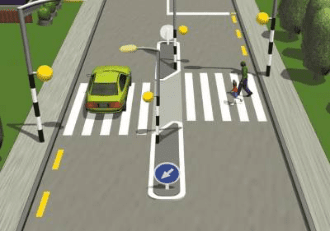Explanation:
Only use the right and center lanes for overtaking to maintain the greatest traffic flow. Other drivers are irritated when you take up the right lane.
Explanation:
Even if there is an emergency lane, stopping on a motorway is riskier. If you have a preventable issue with your vehicle, there is unlikely to be someplace you can solve these issues, and you will create an unneeded hazard. Because freeway speeds are high, having the proper tire pressure is critical. Incorrect tire pressure can impact handling and increase the chance of a tire blowout.
Explanation:
This allows other vehicles to pass without having to cross the separating lines.
Explanation:
You must have had your P1 license for at least 12 months before taking the Hazard Perception Test to graduate to a P2.
Explanation:
The safest place to be is in the emergency lane. In the emergency lane, park as far to the left as possible.
Explanation:
Even when there are streetlights, high beam headlights let you see more clearly. Just keep an eye out for other motorists and bicycles.
Explanation:
Scanning all directions from the car on a regular basis will help you anticipate scenarios when you will need to react.
Advertisement
Explanation:
Reversing is risky since controlling and stopping the car is more challenging. Because your rear brakes aren't as powerful as your front brakes, braking lengths can be extended when reversing.
Explanation:
Leaving your headlights on high beam may dazzle other road users, and parking on the sidewalk obstructs pedestrians and may force them to walk on the road.
Explanation:
You give way to vehicles approaching from your right. Technically, if someone is utilizing a roundabout badly, they might approach from your left (and you should avoid running into them), but this is a highly unlikely scenario. They would probably be at fault in any incident.
Explanation:
First, activate your dipped headlights. If you don't have daytime running lights, this will also turn on your position (park) lights. You can utilize your high beam headlights and fog lights if the need arises. You can keep your position lights on while inside the car if you are parked.
Please select 4 correct answers
Explanation:
You must check your side mirrors, give at least a three-second signal, move toward the center line, and yield to oncoming traffic.
Explanation:
You may overtake if you can see 100 meters ahead after you've finished passing, you won't endanger other drivers, you've signaled for three seconds to alert them, and you're not going faster than the posted speed limit.
Explanation:
Regardless of the type of license, you must have it with you at all times when driving.
Advertisement
Explanation:
Three seconds of signaling will give any following cars enough time to observe your intentions and enough time for you to confirm the road ahead is safe and clear.

Explanation:
You only need to come to a complete stop if a pedestrian is crossing or waiting to cross the crossing on your side.
Please select 4 correct answers
Explanation:
You must dip your headlights for reasons A, B,D, and E. You don't need to dip your headlights if there is no risk of you A, B, D, or E occurring when you are doing a reversing maneuver.
Explanation:
Usually constructed with bricks or pavers, courtesy crossings are raised above the level of the road. Although they are not designated pedestrian crossings, they do offer a location where automobiles can pull over safely so that pedestrians can cross.
Explanation:
You should only use your horn to issue a reasonable traffic warning. The right response is C.
Explanation:
You need to be able to stop along the entire stretch of road that is visible in front of you. If there are no lanes on the road, however, you should be able to stop within half of the distance you can see in front of you.